Laoshan Mountain (崂山, Mount Laoshan, Lao Mountain, or Mount Lao), located in the eastern part of Qingdao City, is the main mountain range of the Shandong Peninsula, with its highest peak, Laoding, reaching an elevation of 1132.7 meters. It is known as the first peak along China’s coastline and is often referred to as the “Number One Mountain by the Sea.” Among all the famous mountains in China, Laoshan is unique as it rises directly from the sea. The coastline around Laoshan stretches for 87 kilometers and is dotted with 18 islands, forming a spectacular seascape around the mountain. Walking along the blue-stone paths of Laoshan, visitors are treated to two contrasting views: on one side, the boundless sea with crashing waves, and on the other side, lush green pine trees and unique rock formations. Hence, it has been described as the “residence of immortals and the abode of wonders” in ancient times.
Laoshan is renowned as a sacred mountain in Daoism, boasting a rich heritage of Taoist culture. At its peak, there were reportedly “nine palaces, eight temples, and seventy-two hermitages,” with over a thousand Taoist practitioners residing on the mountain. Famous figures in Daoism such as Qiu Changchun and Zhang Sanfeng were said to have practiced here. Legends suggest that even Emperor Qin Shi Huang and Emperor Han Wu Di sought immortality here, adding to the mountain’s mystical allure. While many of the original Taoist temples have been damaged or destroyed over time, the Taiqing Palace remains the largest and most ancient among those that have been preserved.
Table of Contents
- Basic Information
- Location and Transportation
- Map of Laoshan Mountain
- Highlights of Laoshan Mountain
- Vlog about Laoshan Mountain
Basic Information
| Estimated Length of Tour | 1 day |
| Ticket Price | Taiqing Palace: 130 RMB Jufeng Scenic Area: 120 RMB BeiJiushui Scenic Area: 90 RMB Yankou Scenic Area: 90 RMB |
| Opening Hours | 7.00 – 17.00 |
| Telephone Number | 0086-0532-96616 |
Location and Transportation
Located on the southern coast of the Shandong Peninsula by the Yellow Sea, Laoshan Mountain is approximately 40 kilometers away from the center of Qingdao city. Positioned between 36°05′ to 36°19′ north latitude and 120°24′ to 120°42′ east longitude, it offers stunning natural landscapes and cultural sites.
Visitors to Laoshan Mountain can explore three main routes:
- Jufeng Route (Giant Peak Route): Ideal for hiking enthusiasts, this route traverses the central part of the mountain, offering challenging trails and breathtaking views.
- Beijiushui Scenic Area (North Route): Particularly captivating after rainfall, this area boasts beautiful waterfalls and lush greenery.
- Yangkou and Taiqing Palace Scenic Area (South Route): Perfect for first-time visitors, this route provides a comprehensive view of the mountain and its connection to the sea.
To reach different parts of the mountain:
- For the Jufeng and Taiqing Palace Scenic Areas:
- By bus: Take bus routes 104, 113, or 304 to Laoshan Tourist Service Center, then transfer to a sightseeing bus.
- For the Yangkou and Huayan Scenic Areas:
- By bus: Board bus routes 109, 383, 615, or 616 to Yangkou Tourist Service Center.
- By metro: Take Line 11 to Puli Station, then transfer to a shuttle bus to Yangkou Tourist Service Center.
- For the Beijiushui Scenic Area:
- By bus: Ride bus routes 112, 619, or 639 to Wolong Village, then transfer to a sightseeing bus.
- By metro: Take Line 11 to Beijiushui Station, and exit at the interchange center to purchase tickets for a sightseeing bus into the scenic area.
Map of Laoshan Mountain

Highlights of Laoshan Mountain
Jufeng Scenic Area (Giant Peak)

Jufeng Scenic Area (巨峰风景区), located in the central part of Laoshan Mountain, boasts an elevation of 1127.3 meters, making it the highest and most rugged scenic area among the nine major scenic spots on Laoshan. The area features attractions such as Yixiantian (a narrow opening between two cliffs), Heifengkou (Black Wind Mouth), Wuzhi Peak, Lingqi Peak, and Natural Stone Pillars. At the peak of Jufeng, there is a square rock named “Gaiding” or “Kezhang,” which can only accommodate three or four people. Due to its steep terrain, climbing Jufeng is challenging. Visitors can approach Jufeng from various directions, such as 15 kilometers east from Liushutai, over 10 kilometers south from Yanyunxi, approximately 5-6 kilometers northeast from Yulinkou, or from the east via Taiqing Palace or west from Mingxia Cave. Accessing Jufeng from routes like Menghunjian or going southwest through Meihunjian is also possible.
“Cloud Sea Spectacle,” “Sunrise Spectacle,” and “Colorful Ball Spectacle” are the three major wonders of Jufeng. Particularly, the “Sunrise Spectacle” is magnificent and exquisite, earning the title of the “Crown of Twelve Scenic Spots of Laoshan” and is considered one of the earliest and best places in China to witness the sunrise over the sea.
Taiqing Palace
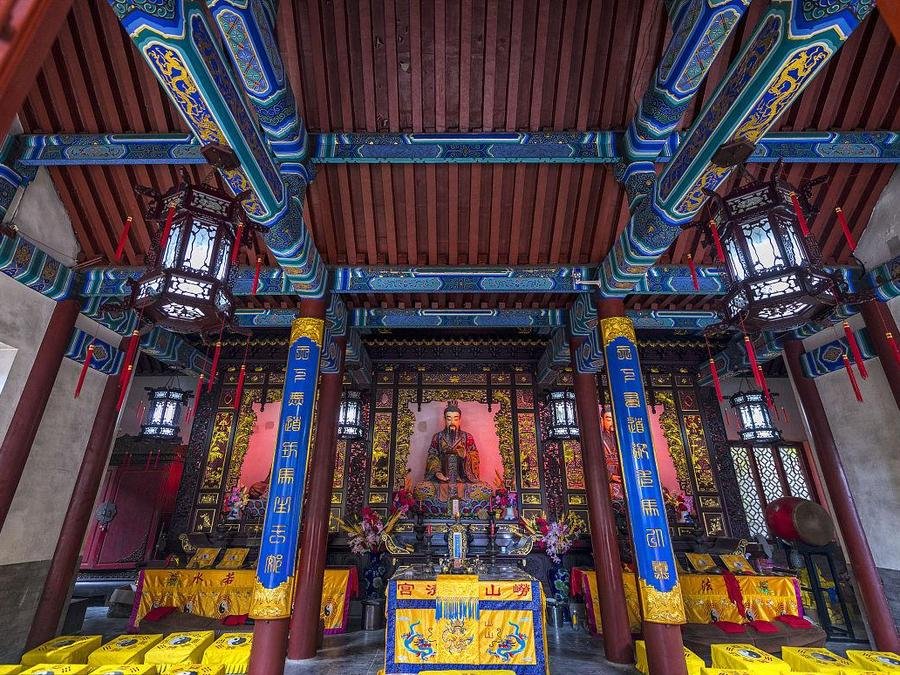
Taiqing Palace (太清宫), also known as Xiaqing Palace, was initially built in the first year of the Jianyuan era (140 BC) during the Western Han Dynasty. It stands facing Taiqing Bay and backed by seven peaks, serving as the ancestral temple of Daoism on Laoshan and the largest Taoist temple on the mountain. It is also the second Daoist sacred site in the world. Located at the foot of Laojun Peak on the southern slope of Laoshan, Taiqing Palace is surrounded by mountains on three sides and faces the sea, presenting picturesque scenery reminiscent of Jiangnan (regions south of the Yangtze River) throughout the four seasons. The palace occupies an area of 30,000 square meters with a total construction area of approximately 2500 square meters, comprising over 150 rooms. Taiqing Palace consists of three independent courtyards, each enclosed by its own walls with a single entrance gate. The architectural style is simple and elegant.
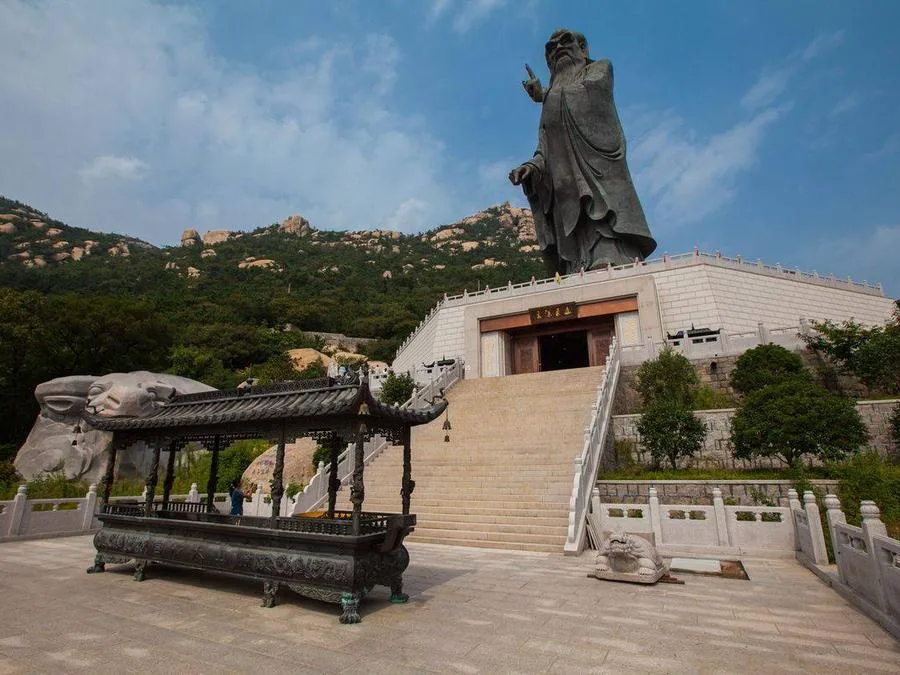
The Three Officials Hall is the largest building complex within Taiqing Palace, consisting of three consecutive courtyards. Inside the hall, there are sculptures of the Three Officials (Heaven, Earth, and Water), as well as deities like Zhenwu (True Martial) and Lei Shen (God of Thunder). The courtyards are adorned with flowers and trees such as Ziwei, Gingko, Peony, and Camellia. Of particular note are two large and intertwined Camellia trees in front of the main hall, one bearing red flowers and the other white. During the transition from winter to spring, these trees bloom for three months, with vibrant red and snow-white flowers, creating a spectacular sight resembling crimson snow. Legend has it that these two Camellia trees were transplanted by the Taoist Zhang Sanfeng from a nearby island during the Yongle reign of the Ming Dynasty.
Yangkou Scenic Area
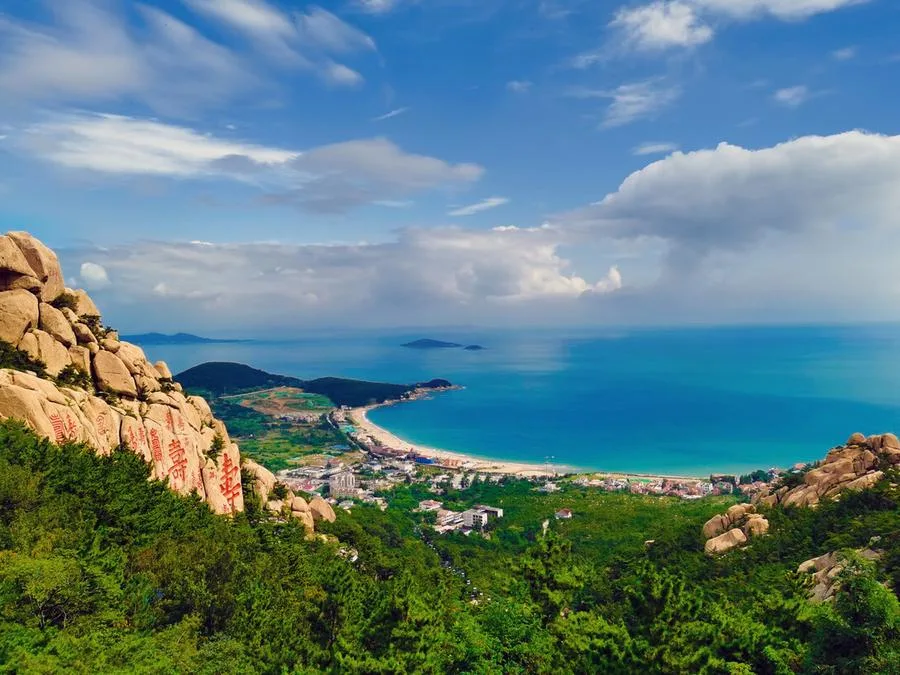
The Yangkou Scenic Area (仰口风景区) is located in the northeast part of the Laoshan Mountain Scenic Area. Amidst the misty peaks, the scenery here is breathtaking, with towering peaks and lush green bamboo and pine forests surrounding the “Palace on the Sea,” known as Taiping Palace. The Guandi Temple is nestled among the towering pines and ancient trees, with a stream flowing in front and bamboo groves nearby. Additionally, the area features attractions such as Shangyuan Mountain, General Gu Peak, Zhongxin Gu Peak, Erxian Mountain, Zuanshi Gu Peak, Mitian Cave, Yangkou Bay, Diaolong Ji, and Fengshan Peninsula, each showcasing the beauty of mountain peaks and picturesque bays.
Beijiushui (North Nine Waters)
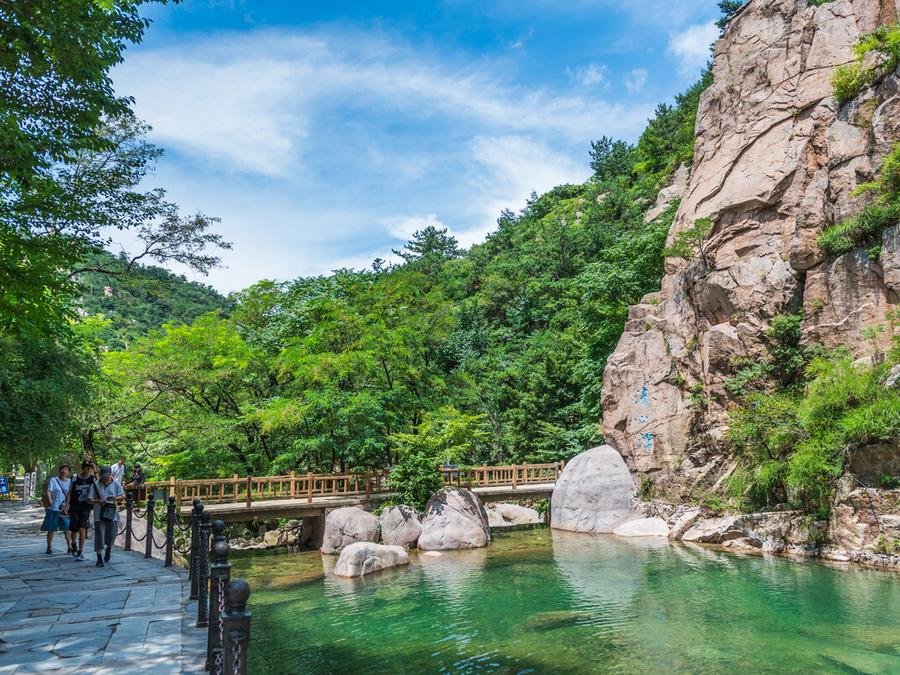
Beijiushui, or North Nine Waters (北九水), derives its name from the nine bends and twists of the river in the upper reaches of the Baisha River. Originating from the water at the northern foot of Jufeng, the river flows through the valley, surrounded by peaks and lush forests, creating a series of stunning landscapes, earning it the nickname “Gallery of Nine Waters.” Beijiushui is divided into Inner and Outer Nine Waters by the Jiushui Boundary Bridge of the Beijiushui Sanatorium, spanning a total length of 9.5 kilometers in the middle reaches of the Baisha River. Combined, the Inner and Outer Nine Waters boast 18 bays, where the river bends around peaks to form deep pools, each with its own unique features and charm. The Beijiushui Scenic Area is also home to the Eighteen Pools, with each pool having its own distinct name and significance. Among the notable pools are Zhirou Pool, Jubei Pool, Weifeng Pool, Wuji Pool, Ziqu Pool, Ziqiu Pool, Zhongxu Pool, Youjian Pool, Deyu Pool, and Chao Yin Waterfall, among others.
Hualou Peak
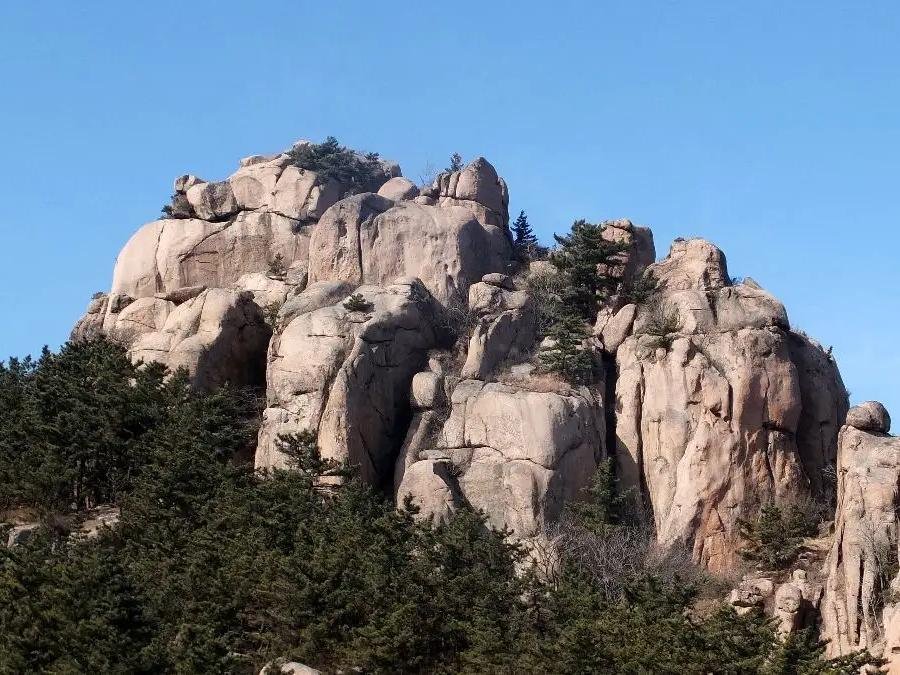
Hualou Peak (华楼峰) is situated on the southern bank of the Laoshan Reservoir, with an elevation of 408 meters. It is a square-shaped rock pinnacle rising from the eastern part of the mountain top, standing over 30 meters tall. Composed of layers of rocks, it resembles a towering building reaching into the sky, hence its name “Hualou,” meaning magnificent building. Due to its unique rock formations resembling a decorative pillar, it is also known as “Huabiao Peak” and was historically referred to as “Juxiantai (the gathering place of immortals).” Among the Twelve Scenic Spots of Laoshan, it is known as “Hualou Stack Stones.” Legend has it that the Eight Immortals crossed the sea and stopped at Laoshan, with He Xiangu grooming herself at Juxiantai, thus giving it the name – “Dressing Tower.” Historical records suggest that renowned Taoist figures like Zhang Sanfeng had mystical connections with this peak, making it one of the celebrated mountains by the sea.
Longtan Waterfall
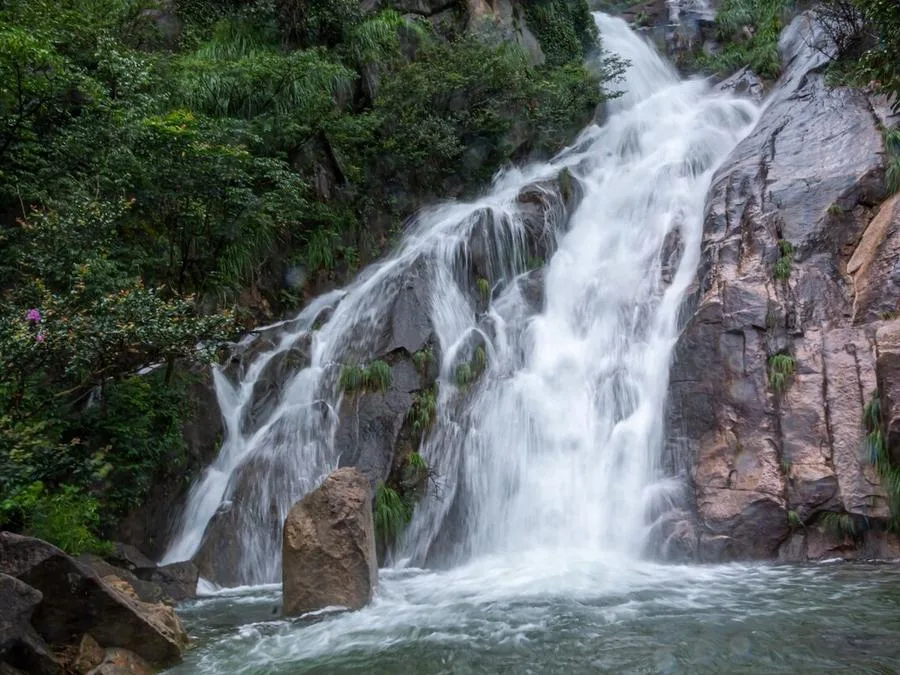
Longtan Waterfall (龙潭瀑), also known as Yulongtan, is located in the midstream of the Baishui River at the southern foot of Laoshan Mountain. Sourced from the valley between Tianchading and Beitianmen, at an altitude of 500 meters, the water cascades down a hundred-foot cliff, resembling a dancing dragon, hence its name “Longtan Waterfall.” The pool beneath the waterfall holds crystal-clear, icy-blue water. After a rain, the waterfall surges with a deafening roar, creating a magnificent spectacle. The stream, gathering from numerous creeks along its path through mountains and ridges, converges into a rushing current. As it reaches a roughly 30-meter-high cliff-top platform, the water jets straight out several feet before plunging down the cliff into the emerald pool below. The water, swirling in mid-air through several twists and turns, merges into a waterfall approximately 30 meters long and 5 meters wide, crashing into the jade pool below. The top of the waterfall is adorned with the calligraphic characters “龙吟,” meaning “Dragon’s Roar,” inscribed by the renowned contemporary calligrapher Huang Miaizi during his visit to Laoshan in 1981. Beneath the waterfall, a large, elongated rock tapers down from the top, providing visitors with a seat from which they can admire the panoramic views of the surrounding peaks while marveling at the majestic waterfall up close.

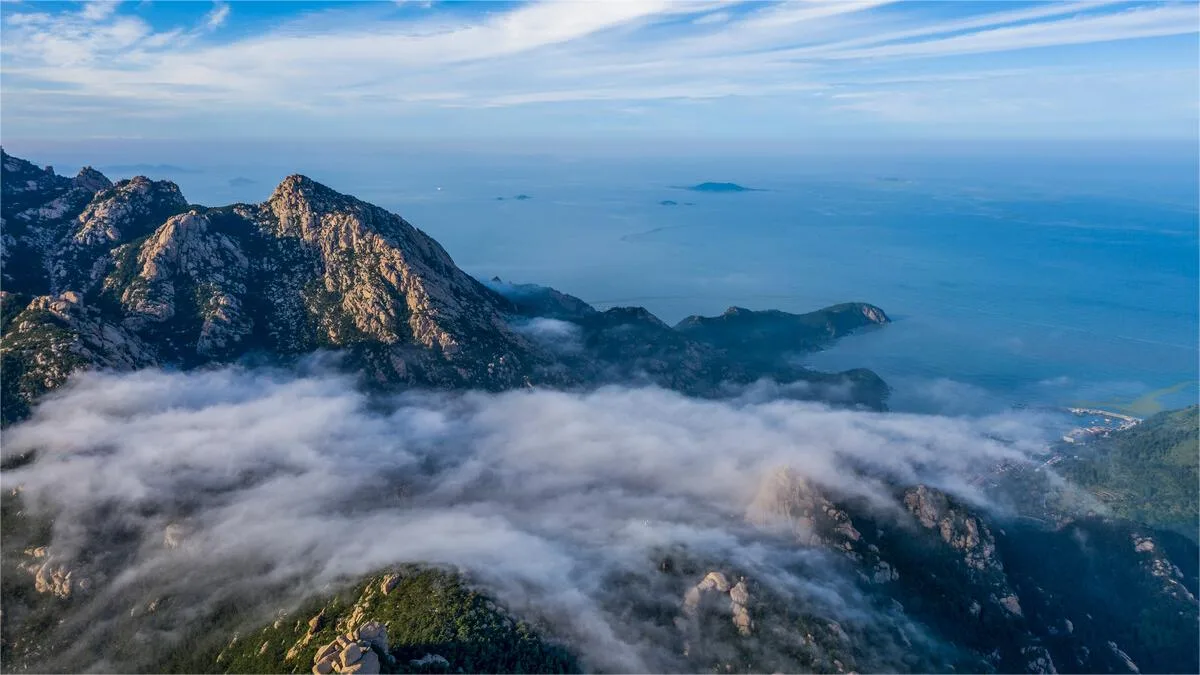

The Beijiushui Scenic Area of Laoshan is exceptionally beautiful after the rain! The streams have plenty of water and are very refreshing.
The trees in the Jiushui Scenic Area are mostly baren. After a short ride on the sightseeing bus, you will find some cherry blossom trees. The pools of water in Jiushui are incredibly clear and as green as emeralds. However, the last stretch of the hike, which leads to the highest point, can be quite steep and narrow, so be sure to be careful.
A Day Trip to Beijiushui in Laoshan. Get off at Exit B of the Beijiushui Station on the Blue Valley Express. Buy your ticket at the ticket office and take a 20-minute bus ride to Beijiushui! We finished exploring Beijiushui in two hours today, taking photos and enjoying the scenery – mission accomplished!
You can take a taxi to Yangkou Community from the city center, which costs around 70 to 80 yuan. Then, you can take the 618 circular sea bus that has air conditioning and charges only 2 yuan. The seaside views along the way are absolutely beautiful! Get off at the last stop and take your time walking down; stop wherever you find something beautiful, and if you want to ride again, just catch the bus back. The distances between stops… Read more »
When we were climbing up the mountain, it hadn’t started snowing yet. Halfway through, it began to snow heavily. The wind was so strong that I couldn’t open my eyes. Soon enough, the road was blocked, preventing cars from coming up and people from going down. We had to take refuge in the security office for two hours.
It’s a rare beautiful day, perfect for visiting Taqing Palace in Laoshan to see the red leaves. This is the most beautiful time of the year at Taqing Palace.
As the temperature drops, the onset of autumn in Jiushui is rapidly progressing. Upon entering the mountains, one can already see the intertwining colors of early autumn in red, yellow, and green. A few maple leaves are slightly turning red, indicating that autumn has progressed about thirty percent. If you want to see vast areas of red, you will likely have to wait until mid to late November. Please note that the road leading from the entrance to Chaoyin Waterfall… Read more »
There aren’t many places to eat in the scenic area. There are no convenience stores, and no chain restaurants either. Most options are individual eateries, and many of them tend to overcharge tourists.
Laoshan – A place that makes you not want to return after your first visit. We spent eight hours in the scenic area, three hours stuck in traffic, and another three hours waiting for the sightseeing bus. The traffic was so bad that I questioned my life choices!! The sightseeing bus requires you to switch buses at every stop, making for a really poor experience! We ended up waiting in line from dawn till dusk.